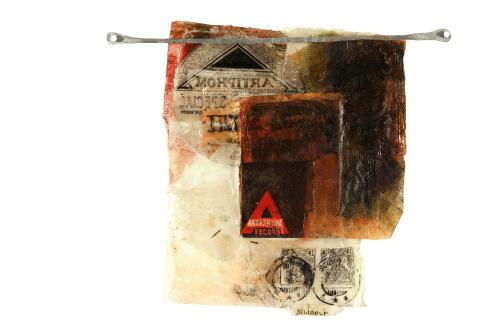PAST TENSE - FUTURE PERFECT Susan Woolf. MATHABO The Future Perfect tense talks about an event in the future as if it was past. For example: “By the time you have perused these artworks, I will have long completed them.” These artworks were designed in what was the present and is now the recent past, using information from the extended past and abstract diagrams from the recent past, yet are expressed for the future. When the viewer sees them, the experience becomes past for the viewer. Yet there are 6 billion possibilities for this artwork to be viewed as there are around 6 billion people on the planet; and because more people are being born every moment, the possibility for these artworks to be new to someone or reinterpreted by a previous viewer corresponds to and even outdistances those numbers. So the artworks remain looped into future perfect… “When you are finished viewing these artworks, there will still be many people after you who will do so.” The past remains fresh for the future, perfectly. FUTURE PERFECT The artworks can be seen from both sides. The second side is an extension of what we experience in the present. There is an expectation of what we will see next (in the future) when we look beyond the first image. The Chequebook stubs included in the artworks from this series represent a diary of chronological events that happened in the past. Purchases written in chequebooks are written in the present for something that will be used in the future. The artworks therefore represent the equivalent of what could be compared to in English grammar as Past Tense, Present Perfect Tense and Future Perfect Tense . The symbolism for the Purchases written in chequebooks are written in the present for something that will be used in the future. Date: These works are being completed during 2008. They are a continuation of theme from Is this Your Face? No! It is the Face of your Mother and Father in 2003 and the Mapping Generations series in 2006 . Media: Aluminium, Rooibos tea bag paper, Chequebook stubs, Inks Size: 30cm x 30cm Framed Double sided 1) Artiphon Music 1932 The label of Artiphon Record Company represents the gramophone recording industry of the past. The proponent Hermann Eisner was a major figure in that industry and the founder of the Company in 1904. Whilst the 78 speed record had been invented in America, Eisner had simultaneously invented his own formula for the manufacture of the 78 speed record in Germany. The Chequebook represents purchases that are written in them. They are written in the present for something that will be used in the future.
top of page
bottom of page
